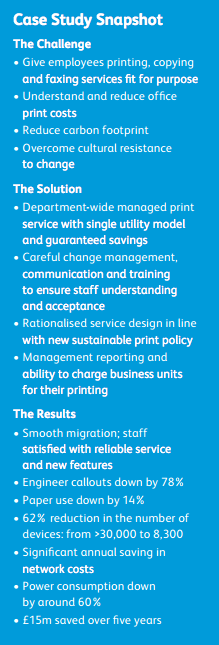Background
Every day the UK’s Department for Works and Pensions (DWP) helps people find work and administers state allowances to those out of work, unable to work, retired, or requiring financial protection. In more than 1,000 DWP offices, employees were using more than a billion sheets of A4 paper every year as they created customer records, filled in and  processed forms and sent millions of faxes as they carried out their day-to-day activities.
processed forms and sent millions of faxes as they carried out their day-to-day activities.
The Challenge
With demand for DWP’s services growing due to recessionary pressures, the department knew that its aging fleet of printers, copiers and fax machines wasn’t up to the job. There were too many different suppliers and models for effective fleet management. The devices were generally old and in poor repair so the department’s employees couldn’t rely on them when doing their jobs. With no management information to
speak of, DWP had little idea how much its office printing, copying and faxing was costing taxpayers; but it knew it needed to upgrade them to be both fit for purpose and more cost-effective. Equally importantly, the department wanted to improve the sustainability of its offices by reducing their use of energy and consumables. Thus was born the ‘Sustainable Print Service’ project.
The Solution
After thoroughly assessing the market, DWP selected Xerox to be its provider for a department-wide managed print service that was set to save DWP £15m over five years.Among the reasons for its choice was Xerox’s ability to take on all of DWP’s existing lease liabilities; and to combine these with all the costs of the deal — including setup and project resource costs; hardware; software; consumables; site-by-site service design; implementation; change management; training; ongoing management and support — into a complete price-per-page utility commercial model.
The project had two key challenges. One was the sheer number of sites and devices: the Xerox assessment discovered that DWP had more than 30,000 devices nationwide. The other challenge was to help DWP staff accept the changes that the new service would bring. Many were used to having their own individual printers; that was going to change. Also, for the first time DWP would have the ability to charge individual business units for every page they printed, thanks to a visibility of costs they didn’t have before.
DWP knew Xerox was up to the job because we’d successfully managed similar challenges in transforming and managing DWP’s document supply chain for its core business documents, mass mailings, bulk copying and other key document production areas.
The Solution
After thoroughly assessing the market, DWP selected Xerox to be its provider for a department-wide managed print service that was set to save DWP £15m over five years. Among the reasons for its choice was Xerox’s ability to take on all of DWP’s existing lease liabilities; and to combine these with all the costs of the deal — including setup and project resource costs; hardware; software; consumables; site-by-site service design; implementation; change management; training; ongoing management and support — into a complete price-per-page utility commercial model.
 The project had two key challenges. One was the sheer number of sites and devices: the Xerox assessment discovered that DWP had more than 30,000 devices nationwide. The other challenge was to help DWP staff accept the changes that the new service would bring. Many were used to having their own individual printers; that was going to change. Also, for the first time DWP would have the ability to charge individual business units for every page they printed, thanks to a visibility of costs they didn’t have before.
The project had two key challenges. One was the sheer number of sites and devices: the Xerox assessment discovered that DWP had more than 30,000 devices nationwide. The other challenge was to help DWP staff accept the changes that the new service would bring. Many were used to having their own individual printers; that was going to change. Also, for the first time DWP would have the ability to charge individual business units for every page they printed, thanks to a visibility of costs they didn’t have before.
DWP knew Xerox was up to the job because we’d successfully managed similar challenges in transforming and managing DWP’s document supply chain for its core business documents, mass mailings, bulk copying and other key document production areas.
Staff now have access to features they didn’t before, such as scanning and secure printing (where a printer releases a job sent to it only when a PIN is entered). Devices are in good working order because they’re remotely monitored and consumables are automatically ordered. If staff have to call the helpdesk their problem can usually be solved immediately. Engineer callouts are down by 78% — another source of savings and a further reduction in DWP’s carbon footprint.Soon after launch, DWP’s sustainable print project won Green IT Magazine’s Green IT Awards’ Public Sector Project of the Year. The Department now has a print service fit for purpose and, through detailed management reporting, the visibility and control to ensure that it stays that way.
The Future
Xerox will continue to work with DWP to deliver more value. The widespread availability of scanning provides opportunities to digitise paper-based processes. The Xerox MFDs also have a programmable interface that lets you scan a document, then press a button to send it straight to the person or department that will process it.
Xerox is also talking to DWP about how to support the print needs of homeworkers and about integrating the management of its office and central reprographic print environments, both currently managed by Xerox.
Click here to download a PDF of this Xerox Case Study



